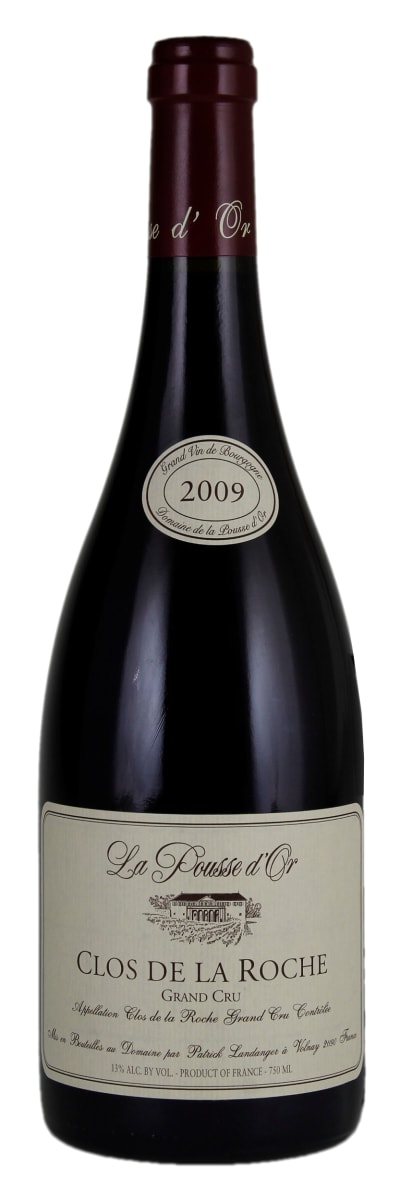Domaine de la Pousse d'Or Clos de la Roche Grand Cru 2009
-
Robert
Parker



Product Details
Your Rating
Somm Note
Winemaker Notes
Professional Ratings
-
Robert Parker's Wine Advocate
The 2009 Clos de la Roche saturates the palate with tons of fruit. Despite its richness, the Clos de la Roche remains brilliant through and through, with dazzling elegance and an intense, powerful finish. Anticipated maturity: 2014-2044. This is a stunning set of wines from Patrick Landager. The vintage yielded a set of super-sized, big wines that may shock some readers for their sheer intensity. These are among some of the most backward 2009s I tasted and will require considerable patience. The estate now farms a total of 19 hectares, which includes the vineyards Landager acquired when he bought Domaine Moine-Hudelot a few years back. In 2009 Landager started harvesting on September 22, when most people were already finished picking. Cuvaison started with 5-6 days of cold maceration and lasted a total of three weeks with one punchdown in the morning and a second in the afternoon. The wines spent 12-15 months in oak (roughly 30% new) on their fine lees with no rackings until they were prepared for bottling, which took place with no fining or filtration. (Note: the Chambolle saw 50% new oak). All of the 2009s were bottled in early February 2010.






Domaine de la Pousse d’Or has for decades been the collector’s choice for expressive and memorable wines from Burgundy’s most hallowed terroirs. This historic estate is one of the Burgundian elite, in a similar realm of such exclusive wineries like Romanée-Conti and Comte de Vogüé, with its strict selection and seamless winemaking. The history of Pousse d’Or in Volnay underscores its influence throughout the ages. In 1855, the winery was part of a larger domaine that included such names as Romanée-Conti and Clos de Tart. Originally called La Bousse d’Or (Bousse, in old French, means earth; thus, “golden earth”), the Domaine changed owners a number of times until legend Gérard Potel took the reins. It was Potel that put the estate’s wines on the map, with the elegant, refined style that Pousse d’Or is still known for today. In 1997, Patrick Landanger purchased the winery and its vineyards. In the mid-2000s, Landanger added an impressive collection of Côte de Nuits vineyards (from Domaine Moine-Hudelot) to his portfolio. Pousse d’Or has three premier cru monopoles, or exclusively estate-owned vineyards, in Volnay: ‘Clos de la Bousse d’Or,’ ‘Clos des Soixante (60)-Ouvrées’ and ‘Clos d’Audignac.’ Pousse’s attention to detail and dedication to organic viticulture (the estate is not certified but has followed organic principles for years) is serious. Vineyards are cared for without the use of pesticides or herbicides and are regularly plowed. Grapes are harvested and sorted by hand, and bunches are destemmed and fermented on indigenous yeasts in temperature-controlled tanks. Wines are aged from 15 to 18 months in French oak barrels, with between 30 to 50 percent new wood, depending on the cru. In recent vintages, Landanger has been experimenting with terracotta amphorae for aging some of his premier cru wines. All wines are bottled by gravity and are unfined and unfiltered.

Thin-skinned, finicky and temperamental, Pinot Noir is also one of the most rewarding grapes to grow and remains a labor of love for some of the greatest vignerons in Burgundy. Fairly adaptable but highly reflective of the environment in which it is grown, Pinot Noir prefers a cool climate and requires low yields to achieve high quality. Outside of France, outstanding examples come from in Oregon, California and throughout specific locations in wine-producing world. Somm Secret—André Tchelistcheff, California’s most influential post-Prohibition winemaker decidedly stayed away from the grape, claiming “God made Cabernet. The Devil made Pinot Noir.”

While Morey-St-Denis of Burgundy might not get the same attention as its neighbors, Gevrey-Chambertin to the north and Chambolle-Musigny to the south, there is no reason why it shouldn’t. The same line of limestone runs from the Combe de Lavaux in Gevrey—all the way through Morey—ending in Chambolle.
There are four grand cru vineyards, moving southwards from the border with Gevrey-Chambertin: Clos de la Roche, Clos St-Denis, Clos des Lambrays, Clos de Tart and a small segment of Bonnes-Mares overlapping from Chambolle. Clos de la Roche is probably the finest vineyard, giving wines of true depth, body, and sturdiness for the long haul than most other vineyards.
Pinot Noir from Morey-St-Denis is known for its deep red cherry, blackcurrant and blueberry fruit. Aromas of spice, licorice and purple flowers are present in the wines’ youth, evolving to forest and game as the wine ages.
